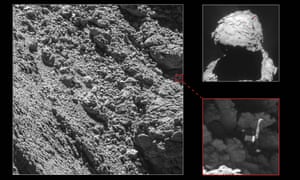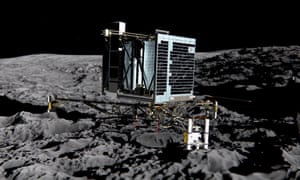Extract from The Guardian
Almost two years after it touched down on the surface of comet 67P, the Philae lander has been found.
In images taken just three days ago by a camera on board the Rosetta space probe, the lander can be seen nestled in a dark crack on the comet’s surface, with two of its three legs sticking out.
“For many people it is a huge emotional closure, but for the scientists it is incredibly important because it now tells us where the measurements were taken that we made with Philae back in 2014 - that context is everything,” said Mark McCaughrean, senior scientific adviser at the European Space Agency (ESA).
About the size of a washing machine and featuring a host of scientific instruments, ESA’s lander was released from the Rosetta space probe on 12 November 2014, touching down on the rubber-duck shaped comet 67P/Churyumov-Gerasimenko after a nail-biting, seven-hour descent. At the time the comet was 320m miles from Earth, and this was the first time a manmade object had landed on a comet.

In images taken just three days ago by a camera on board the Rosetta space probe, the lander can be seen nestled in a dark crack on the comet’s surface, with two of its three legs sticking out.
“For many people it is a huge emotional closure, but for the scientists it is incredibly important because it now tells us where the measurements were taken that we made with Philae back in 2014 - that context is everything,” said Mark McCaughrean, senior scientific adviser at the European Space Agency (ESA).
About the size of a washing machine and featuring a host of scientific instruments, ESA’s lander was released from the Rosetta space probe on 12 November 2014, touching down on the rubber-duck shaped comet 67P/Churyumov-Gerasimenko after a nail-biting, seven-hour descent. At the time the comet was 320m miles from Earth, and this was the first time a manmade object had landed on a comet.

But there was a snag. Philae’s two harpoons, which were supposed to anchor the lander, did not fire and Philae bounced across the surface of the comet. The lander finally came to rest near a cliff, but the shady location meant that, except for a brief interlude in mid-2015, its solar panels were unable to catch the sun’s rays.
Despite the bumpy ride, the lander was able to send back valuable data before its batteries ran out, offering insights into the comet’s make-up and properties of its surface.
While researchers were able to narrow down its location to a few tens of metres, its precise location remained a mystery, until now.
“We had some images from further away that looked a bit like the lander, but we really needed this unambiguous [image],” said Matt Taylor, the ESA’s Rosetta project scientist. “We needed that to say ‘yes, it is definitely Philae.’”
News of the discovery, said Taylor, reached him late at night over the weekend. “It is a typical thing with Rosetta, things seem to occur at the weekends and usually on Sunday.”
The discovery of the lander’s location, he said, would help scientists to interpret information that it gathered before its batteries ran out.
“It allows us to go back to the data that Philae took to put it into context a little bit more,” he said.
Among such measurements, are data collected by the Consert instrument, which fired radio signals between the lander and the Rosetta orbiter to probe the internal make-up of the comet. “Having the precise location of the lander allows you to refine those measurements and get much better resolution from those,” said Taylor. “It provides us with the ground truth.”
The news comes just weeks after communication with the lander was severed. In July scientists said farewell to Philae after deeming it to be in a state of “eternal hibernation”. The voice of the lander tweeted: “It’s time for me to say goodbye.”
The Rosetta mission itself is shortly to come to an end, with the probe due to be set on a collision course with the comet later this month.
“What we are doing at the moment is actually more complicated than when we deployed Philae itself,” said Taylor, adding that Rosetta was being put in ever-closer orbits around the comet, yielding new data about 67P’s low atmosphere.
Finding Philae, he says, was a timely discovery. “I think it is a nice prelude for the end of the mission,” said Taylor. “It’s bloody exciting.”

No comments:
Post a Comment